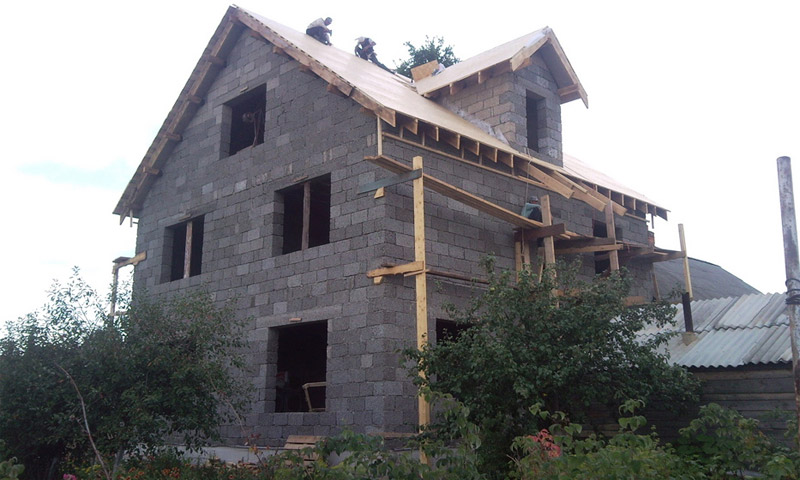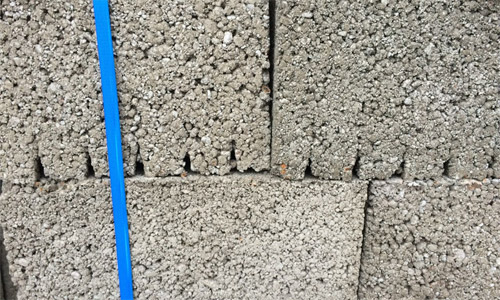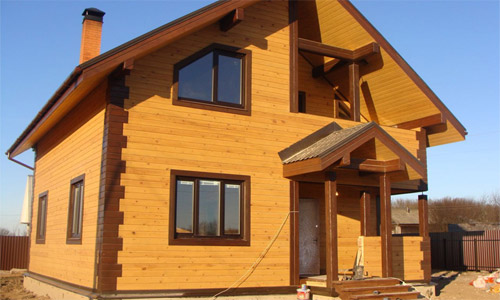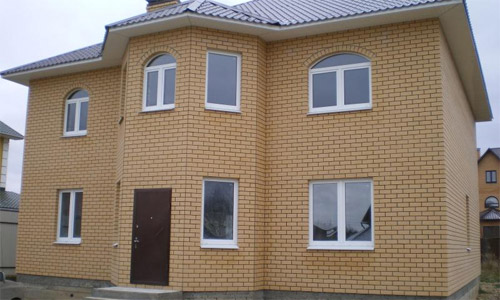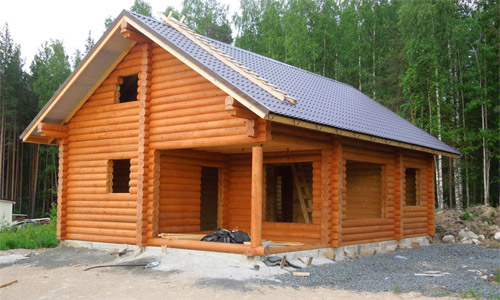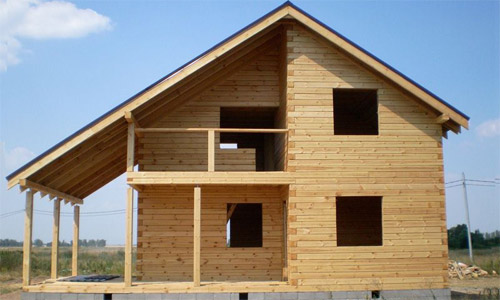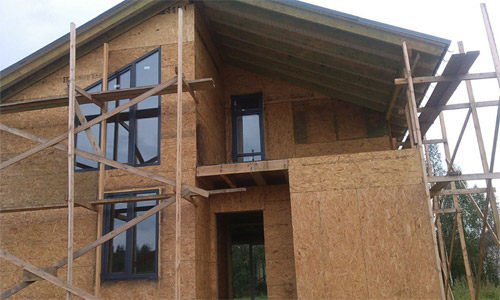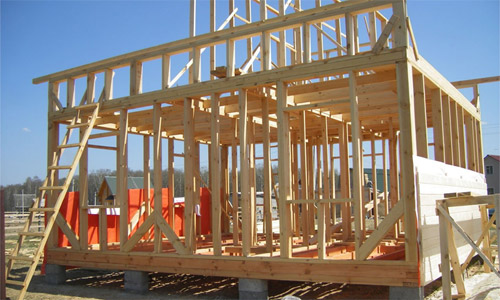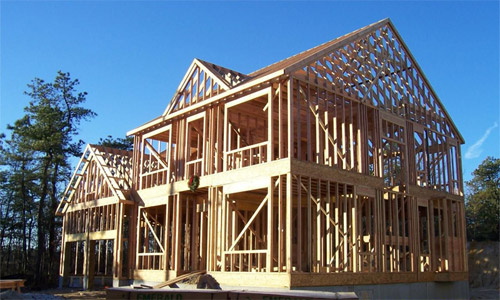A comment
It's time to build your house.
Perhaps with excessive meticulousness, I began to study the properties of materials for masonry walls and now you will understand why and how. It consisted of two stages.
First stage:
I compared the properties of different materials, and by this I will immediately tell you my opinion on them:
1. Gas silicate blocks are fragile, easily absorb moisture, are not practical in terms of attaching anything to this material, since after watching a video on the Internet I was convinced that even at the construction stage some skill is required so that the formwork for the armo-belt does not come off walls.
And from the architect I learned one information that is logical, but which everyone is silent about - gas blocks with their ability to absorb moisture, dry the air in the room and this adversely affects the respiratory system.
2. Brick. Yes, I initially wanted a house made entirely of ceramic bricks. Strong and natural material. I lived in an apartment with a wall thickness of 2 bricks + 100mm insulation + then a 40mm ventilation gap + facing the brick floor. Wall thickness 80 cm.
BUT!. I have a plot just 15m wide. we remove 3m from the fence on each side - 2 times 80cm, only 7.4m of usable width remains in the house, and the foundation for such a house will require a very powerful one. And the brickwork is more expensive. In general, not my option turned out to be.
3. Ceramic blocks + insulation. About 6 years ago, when I first thought about construction, I really liked them and turned out to be a worthy alternative to ceramic brick, since the house is lighter and the foundation for such a powerful one is required, and put it quickly.
But somehow I had experience doing repairs in an apartment in the LCD Solar. The developer is a new don. The house was frame-monolithic, and the external walls were made of ceramics. I really didn’t like it; when I tried to drill a drill, I literally broke through the partitions of the block, which made it difficult to fix even the GCR profile.
4. Expanded clay block - this is the solution! BUT! again it was not there! It is still cold, and if you use it, then for the construction of household buildings. To admit it was a fallback if I can’t find anything more worthy.
5. Frame house. I call such houses a heater house. Well, I have a stereotype that a house is a fortress and it shouldn’t be made of cotton and plywood.
6. And finally, ARBOLIT. I heard about this material from a friend who was also about to build. At first I was skeptical of this type of material.
But, after weighing everything, I realized that it should be a warm and strong material, because the chips are intertwined with each other and fixed with concrete - strength, and the fact that 90% of the wood in the block is warm. And here the fun began! My RESEARCH in this area will be pulled for the whole dissertation))) I will try meekly and that's it.
Second phase:
Research and selection of wood concrete.
1. It all started with the fact that a friend praised me for this material, and at the same time said that you can significantly SAVE if you build a house from MONOLITHIC arbolit. Judge for yourself 1m3 of wood chips costs 500 rubles. 4 bags of cement - 1000 rub. Voila! only 2500r / m3 + labor and NO COOL BRIDGES!
About a month I studied technology, watched a video, looked for monoliths, who would help to implement the plan and FOUND! The team that raised about 50 houses from monolithic wood concrete told me that it is better to lay out blocks, the main thing is to choose good quality. WHY? Because 1.It is extremely difficult to pour perfectly even walls.
2. This is not concrete, and stupidly fill and vibrate will not work. It is necessary to knead a maximum of half a cube in a makeshift mixer from a barrel and raise it into the formwork with buckets, laying out 20 cm each and ramming the end of the board or timber. In short, hemorrhoid is complete. In addition, work on it will be released at least 5t.r. per cube (if hired) + formwork But the main drawback is the lack of seams and cold bridges.
The main problem is that it is impossible to fill everything in one day. have to fill in layers. Subsequently, a crack appears at the junction of the layers. And you won’t be able to win at the price with arithmetic 500 + 1000 + 5000 + formwork + inventions for mixing the mixture ... The solution is to look for arbolite blocks of decent quality.
2. Search for high-quality wood concrete. I learned from the Internet that high-quality wood concrete is quite dense, with even geometry, and in compliance with the right production technologies. Key: Chips of the correct form (needle), which provides better weaving inside the block, the correct vibrocompression in the form, and most importantly - that would not be an instant stripping, but only after a day. WHY? everything is simple.
Having stuck a brick out of chips and concrete, it is necessary to fix it and restrict movement, because wood has the ability to absorb moisture during the entire drying process, respectively, if you remove formwork instantly, then the chips in the block swell, straighten and spread out, making the block more loose and distorting its geometry.
I traveled all arbolitovye production in the Samara region, which I could only find via the Internet. In Chernivka, the blocks are more porous, the chips are large (by the way, they said that they will switch to smaller chips from the 2019 season), the geometry walks, especially the upper part of the block, which has a convex rough surface.
I took a sample. Reached the production at 116km. Also loose block. You pick it up and feel like it's half empty. And so I got to Andrew, arbolit-tlt.ru in Togliatti. Outwardly, the blocks had the correct geometry, did not crumble in their hands, like other blocks.
But, after watching a video on the Internet, I was eager to expose the block to hammer blows. For these purposes, he took a blocking block from Andrei. By the way, it was a sunny day in April, the snow had already disappeared everywhere, the flight with the blocks was right in the sun, I lifted the block block. 15 cm thick, and it is icy. Can you imagine a thermos?
And this is only 15 cm, and it is recommended to build external walls from 30 cm. This fact inspired me very much, because obviously such a house does not need to be insulated. By the way, the insulation of the 50th insulation and plaster would cost 1500r / m2 with the material. The facade area of my house is 200m2. In total, this procedure would require 1,500 x 200 = 300,000 rubles. Can you imagine ??? For comparison, the cost of arbolite blocks to my house in 2 floors with an area of 160 m2 - 350 000 rub. That's all arithmetic.
Then the fun began! For 2 months I rolled this block in the trunk, showed it to all my friends, and most importantly, to the designers. I was looking for a designer who already had experience working with wood concrete, but everyone, like lepers, imposed gas blocks on me.
I freaked out, led the unfortunate designer to the trunk, pulled out a block, hit the block several times with a hammer, then gave it a try. And the block only crumpled at the point of impact by 1.5-2 cm. In general, the block has undergone at least 50 sweeping strikes. (For comparison, a similar Chernovtsky partition block crumbled after the 3rd blow).
After that I asked questions: What do they dislike about this material? and how does he think his vaunted silicate will crumble after the first or second strike? Thoughtfully muttered something. But in general, I realized that it was beneficial for someone to recommend gas blocks, while someone was stupidly used to working with them.
In general, it turned out that the only production in the Samara region. where the production technologies ensuring quality are maintained - this is from Andrey in arbolit-tlt, therefore he ordered it from him. Sam from Samara. In Samara, Chernivsk blocks are sold at 4,000 r / m3, while Andrei at 4,600 r / m3 + delivery from Togliatti to Samara is more expensive, but I am ready to pay for the quality.
The only thing I still haven’t figured out is how thick the wall should be. I wanted 40 cm, but Andrei, as well as 5 more people who already live in arbolite houses, said that they have 30 cm walls and the houses are very warm + I watched a video on the Internet where, at a thickness of 30 cm and frost, -15 degrees the cost of heating a house with an area of 160m2 per month is only 2000-2500r. I am in Khrushchev for 43m2 the same amount I give for heating))
Now I fill in the grillage, in 7-10 days I plan to start laying the walls, and in the meantime, my blocks are stored in the production at Andrey, for which I thank him separately.
I recommend this particular manufacturer to everyone. In terms of production, too, everything is clear.
Who cares, subscribe to my channel, so as not to miss https://clck.ru/HQr9V A little later I will start to upload useful videos in the construction of your house. From the foundation to the beautification.
pros
Environmental friendliness, profitability, heat, good geometry, reliability, durability.
Minuses
The absence in Samara, you have to pay extra for delivery from Togliatti.
